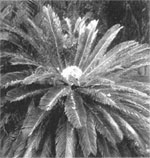Back from plant heaven
Back from plant heaven

cycads are, perhaps, some of the oldest, rarest and most endangered plants in the world right now. As their habitats have been destroyed through the years, these plants have acquired the status of collector's items, leading to an unprecedented rise in the demand for rare species. The recent outcry against several cases of unscrupulous plundering of cycad sites in South Africa shows that the nation is aware of the threat that these fragile plants are facing today ( Veld and Flora , Vol 83, No 4).
One way to ease this threat to the existence of the South African cycads could be to micropropagate them. Central American cycads have already been put into tissue culture, and that too successfully, a fact which affords conservationists of the South African cycads some hope. And recently, Anna K Jager and Johannes van Staden from the Pietermaritzburg-based University of Natal's department of botany teamed up with noted cycad expert Roy Osborne with that goal in mind. They chose to work on the following five species of the endangered plant: Encephalartos ( E ) cycadifolius , E dyerianus, E ferox , E natalensis and E woodii .
Of these, E woodii is the most crucial to tissue culture since it is possibly the rarest plant in the world. Only male plants of E woodii are known







